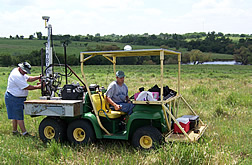| 
Above, ARS scientists Mike Murphy (left) and Rob
Erskine measure soil moisture in an Oklahoma pasture. Some of that moisture
will drain through the soil beneath the root zone to recharge groundwater
reserves. Hydrologist Tim Green’s simulation studies in Australia show
that climate change impacts this process. Photo courtesy
Tim
Green.
|
|

|
Climate Change and Groundwater Recharge
By Laura
McGinnis
August 31, 2007 Elevated levels of carbon dioxide
(CO2) in the Earth's atmosphere could seriously impact air, weather and
vegetation. Now a scientist with the Agricultural Research Service (ARS) is taking a closer look at what could
happen underground.
If atmospheric CO2 levels double within this century, as many climate models
predict, some areas could experience large increases in the rate of groundwater
recharge, the process by which water filters through the soil and enters
aquifers. That's the conclusion of a recent study conducted by ARS scientist
Tim
Green, a hydrologist in the agency's
Agricultural
Systems Research Unit at Fort Collins, Colo.
Green worked with Australia's Commonwealth Scientific and Industrial
Research Organisation (CSIRO) to investigate
how climate change impacts groundwater and the vadose zone, the region between
soil surface and water table.
The rate at which water filters through the vadose zone is controlled by
interactions between soil, water and plant systems. Green and his colleagues
found that this rate was increased by the changes in precipitation and
temperature that elevated CO2 levels are expected to bring about.
The scientists developed a method for simulating the effects of elevated CO2
levels on plants, groundwater and the vadose zone. Then they applied it to two
locations in Australia—one subtropical, one Mediterranean—where
eucalyptus, pine and native perennial Australian grasses grow. They found that
the Mediterranean location responded more to temperature changes, whereas the
subtropical climate was more influenced by the frequency and volume of
precipitation.
In both locations, changes caused to soil, precipitation and plant
transpiration by simulated climates with twice the existing CO2 led to
significant changes to the rate of groundwater recharge. Water recharged from
34 percent slower to 119 percent faster in the Mediterranean climate, and from
74 to 500 percent faster for the subtropical climate.
While the opportunity for decreased recharge rates exists, the general trend
is towards increase. Future research will investigate whether those changes
would benefit or harm those ecosystems.
A paper on this research was published in the August issue of the Vadose
Zone Journal.
ARS is the U.S. Department of
Agriculture's chief scientific research agency.